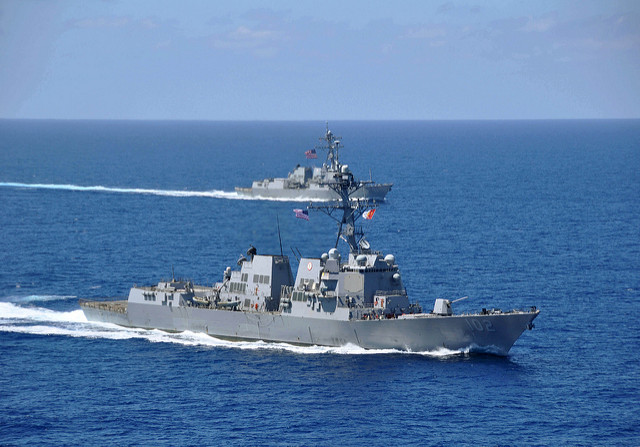 Courtesy of US Navy on Flickr
Courtesy of US Navy on Flickr
The Incoming Administration Must Remain Vigilant & Engaged in the South China Sea
By Andrea Wert, WiSe Leadership Initiative Fellow

MH-60R Sea Hawk helicopters assigned to the Wolf Pack of Helicopter Maritime Strike Squadron (HSM) 75 maneuver over the South China Sea. Image Courtesy US Navy Official Flickr.
Although all-out war is unlikely in the South China Sea, risk of major conflict will remain for decades. China, Taiwan, Vietnam, Malaysia, Brunei, and the Philippines have overlapping territorial and jurisdictional claims in the Sea through which $5 trillion of annual trade passes, and which hosts critical fisheries and extensive fossil fuel reserves. The United States must remain vigilant against the following concerning developments.
First, extensive Chinese island building, growing regional military presence, and controversial U.S. FONOPS increase the risk for conflict from military miscalculation or accidental encounters at sea. Even if not directly involved, the United States could be pulled into regional conflict to uphold its defense treaties and security agreements.
Second, China’s island building, nine-dashed line claim, and provocative military actions threaten to slowly change the regional status quo and international norms under the United Nations Convention on the Law of the Sea (UNCLOS). Chinese refusal to acknowledge The Hague Tribunal’s July ruling threatens to erode the effectiveness of the International Court of Arbitration and international law more broadly.
Third, deteriorating relations with the new administration in the Philippines threatens to dismantle a key U.S. alliance and military base. President Duterte has called for the end of U.S.-Philippine joint operations and the removal of all U.S. troops within the next two years. The loss of a strategic ally and rotational bases would be a blow to U.S. alliance policy. This comes at a time when the failure of TPP in the U.S. has raised questions of the effectiveness of American influence in the region.
Fourth, increased U.S.-China tensions in the South China Sea threaten to hinder progress on other global national security challenges. The incoming administration’s unclear policies on China create additional uncertainty. These and other unexpected changes could trigger the eruption of these unresolved territorial disputes.
To reduce the risk of stirring up these unresolved disputes in the South China Sea, the incoming administration should pursue the following policies:
- Ratify TPP while pursuing new FTAs and supporting Chinese economic initiatives. The Trump administration must reconsider withdrawing the United States from TPP. Beyond the economic benefits to U.S. business, TPP aids national security by increasing regional engagement, raising trade standards, and cultivating economic interdependence. Beyond TPP, the U.S. must pursue bilateral or multilateral FTAs with other nations in the Asia-Pacific. The more economic interdependence created, the costlier conflict becomes. Economic policy must remain a critical part of broad U.S. security policy. The United States should also support China’s economic initiatives, as increased Chinese engagement with its neighbors increases the cost of regional conflict for China.
- Increase joint military exercises and training in the region to reduce the risk of military miscalculation while increasing preparedness to operate with allied militaries in the event of conflict.
- Reaffirm commitment to U.S. allies and partners in the region and set clear, common values and issue areas where the U.S. and each partner can work together.
- Outline and work on clear areas where the U.S. can work successfully with China, continuing progress on international issues such as climate change, cybersecurity, and terrorism. The United States should also conclude negotiations for the Bilateral Investment Treaty (BIT); increasing economic interconnectedness increases the cost of conflict for China.
- Define and keep classified a specific “red line” for Chinese aggression in the South China Sea and options for a leveled response to such actions. If no red line is defined and the U.S. is not prepared to engage, China will slowly continue to change the status quo in the South China Sea.
- Maintain ties and constant communication with ministerial and other levels of the Philippine government. State Department officials must maintain a strong dialogue and positive relationship with their Philippine counterparts, despite presidential rhetoric which threatens to permanently set back the mutually beneficial U.S.-Philippine alliance.
- Ratify UNCLOS and vocally support the rulings of The Hague. As a world leader, the United States must be a steadfast supporter of the international system and international law. Ratification of UNCLOS sends a strong message to the world the U.S. remains committed to the international maritime system and rejects any actor’s desire to change the status quo.
Each nation’s steadfast maritime claims and refusal to concede territory prevents resolution in the foreseeable future. As outlined above, the kindling for conflict already exists. However, the United States in coalition with its allies and partners in the region, can take steps to prevent a spark of major conflict in the South China Sea.






Interesting article! I agree with nearly all your recommendations. But I’m a bit perplexed by the suggestion of a classified red line. Would it be best for Washington to make this red line clear to Beijing’s leadership? If not, wouldn’t having a secret red line be a dangerous liability as we wouldn’t be able to credibly deter Chinese aggression just shy of that red line, and suddenly it would compel a reaction of military force? Thanks!
Hunter, thank you for your feedback, and I agree with your point. I think when I was writing I was thinking more in the short-term and for the beginning of the new administration…an internally defined redline the incoming administration would use to define priority level to the situation. One could argue this is already a matter of top priority. I do agree a publicly defined red line & carefully considered leveled response is crucial to deterrence of Chinese aggression in the South China Sea. Thanks for pointing this out!
Interesting timing having President Xi at Mar-a-Lago while the U.S. carried out retaliatory missile strikes in Syria…whether considered in the response or not, this definitely sends a strong message to President Xi: The current administration is willing to take unilateral military action abroad if actions by a foreign leader are deemed unacceptable.